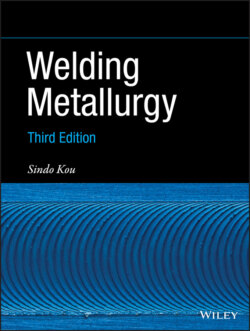Читать книгу Welding Metallurgy - Sindo Kou - Страница 74
2.2.2.3 Step‐by‐Step Application of Rosenthal's Equations
ОглавлениеThe procedure for calculating thermal cycles is illustrated as follows. Equation (2.9) for 3D heat flow is used, with V = 2.4 mm/s, Q = 3200 W and T o = 25 °C. Consider the temperature distribution along the straight line of y = 4 cm.
Step 1. Calculate T (1, 4). Let x = 1 cm, y = 4 cm, R = [(1)2 + 42 + 02]1/2.
Step 2. Calculate T from Eq. (2.9) using k and α of the workpiece material (e.g. steel).
Step 3. Repeat Steps 1 and 2 for x = −1, 0, 1, 2, 3, 4, 5 cm.
Step 4. Sketch the temperature distribution T (x, 4, 0).
Step 5. Convert temperature distribution T (x, 4, 0) into thermal cycle T (t) by dividing x by V.
Figure 2.19 explains how to convert the calculated temperature distribution in Figure 2.18 to a thermal cycle. It is assumed that the workpiece in Figure 2.18 is long enough such that, with respect to the moving coordinate system, the temperature field does not change. The T – x plot, i.e. the temperature distribution along the welding direction, can be converted into T – t plot, namely, the thermal cycle, by calculating time t using t = (x − 0)/V. For instance, assume the travel speed of the heat source is V = 4 mm/s. At the point x = 2 cm, y = 4 cm, and z = 0 cm, t = (20 mm − 0)/(4 mm/s) = 5 s.
Figure 2.19 Converting the calculated temperature distribution in Figure 2.18 to thermal cycle, assuming the temperature field is steady with respect to the moving coordinate system.
The shape of the weld pool can be calculated such as at the top surface of the weld pool, i.e. at z = 0 cm. Let T L be the liquidus temperature of the workpiece material, e.g. 1530 °C for steel. The liquidus temperature of an alloy is equivalent to the melting point of pure metal T m, above which the workpiece material is melted completely. The procedure for calculating pool shape is illustrated using Eq. (2.9) for 3D heat flow and V = 2.4 mm/s, Q = 3200 W and T o = 25 °C.
Step 1. Let T = T L in Eq. (2.9). Calculate R at x = 0 cm and z = 0 cm from Eq. (2.9) by substituting into the equation the values of T o , V, Q, and the physical properties of the workpiece materials (e.g. steel) k and α.
Step 2. Find the value of y from R = (02 + y 2 + 02)1/2.
Step 3. Repeat steps 1 and 2 for x = 1 cm, 2 cm, etc. Use the calculated y values to construct the pool shape at the workpiece surface.
Let T H be the temperature at which solid‐state phase transformation occurs (e.g. 780 °C). The shape of the HAZ can be calculated, such as at the top surface of the weld pool, i.e. at z = 0 cm, following the same procedure for calculating the pool shape except that T = T H in Step 1. The distance in y‐direction between the weld pool shape (isotherm T L) and the HAZ shape (isotherm T H) is the width of the HAZ.
